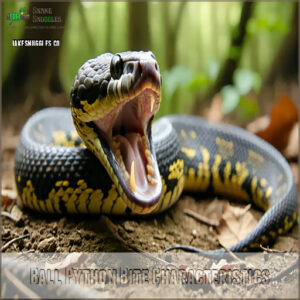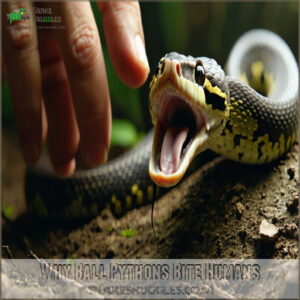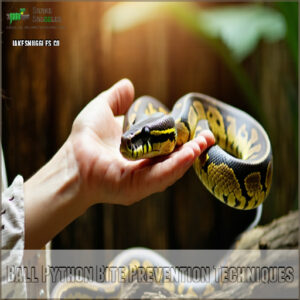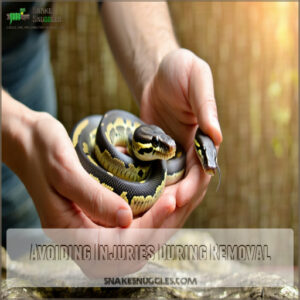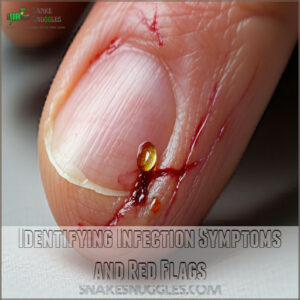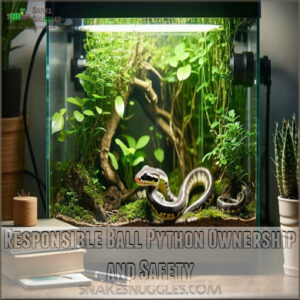This site is supported by our readers. We may earn a commission, at no cost to you, if you purchase through links.

These non-venomous snakes pack about as much punch as a cat scratch – think of it as a firm pinch rather than a serious injury.
While their bites can leave small puncture marks and minimal bleeding, they’re more of a surprise than a threat.
The biggest risk isn’t the bite itself but potential infection, which you can prevent with proper wound care.
Like most pets, ball pythons aren’t out to get you – they’re usually just stressed or confused.
Understanding their body language can make all the difference between a happy snake and a startled one, and knowing they are non-venomous helps in handling them safely.
Table Of Contents
- Key Takeaways
- Ball Python Bite Characteristics
- Are Ball Python Bites Really Dangerous
- Why Ball Pythons Bite Humans
- Ball Python Bite Prevention Techniques
- Safe Removal of a Latched Ball Python
- Ball Python Bite Care and Treatment
- Signs of Infection to Watch For
- Preventing Future Ball Python Bites
- Responsible Ball Python Ownership and Safety
- Frequently Asked Questions (FAQs)
- Are ball python bites dangerous?
- Are ball pythons venomous?
- Can a ball python bite a dog?
- What happens if a ball python bites you?
- Are ball pythons irritable?
- Can a ball python bite harm a cat?
- What happens if your ball python bites you?
- Do pet ball pythons carry diseases?
- Are python bites dangerous?
- Can you get an infection from a python bite?
- Conclusion
Key Takeaways
- Ball python bites aren’t dangerous—they’re non-venomous and cause only mild pain, small puncture marks, and minimal bleeding.
- Most bites happen due to stress or hunger, but understanding their behavior helps you prevent them.
- Clean any bite thoroughly to avoid infection, and monitor for signs like redness, swelling, or pus.
- A calm approach, proper handling, and a secure enclosure keep both you and your python safe.
Ball Python Bite Characteristics
You’ll find that ball python bites are rarely serious, but they can still leave small punctures and minor discomfort.
These bites are typically more surprising than painful, often feeling like a firm pinch with little bleeding, which can be described as a firm pinch.
Physical Effects of a Ball Python Bite
How bad are ball python bites, really?
Most of the time, they’re more of an inconvenience than an injury.
These snakes have tiny, backward-curved teeth meant for holding, not harming.
If you get bitten, here’s what to expect:
- Small puncture marks, often forming a curved shape.
- Minimal bleeding, thanks to their short teeth.
- Surface-level scratches rather than deep cuts.
- A shock factor that’s worse than the physical sting.
Pain Assessment and Duration
A ball python bite typically causes mild to moderate pain, much like a cat scratch or a firm pinch.
Pain levels vary, but most bite wounds stop hurting within a few hours or days.
If soreness lingers, it’s usually tender, not unbearable.
Severe cases, though rare, involve sharper discomfort and longer soreness duration.
Immediate injury response, like cleaning and dressing the wound, speeds up healing time.
Bleeding and Infection Risks
A snake bite can surprise you, but bleeding is typically minimal after a ball python bite.
Small puncture marks mightn’t seem like much, but wound care is essential.
Without proper cleaning, there’s a real infection risk from bacteria in their mouths.
Signs like redness, swelling, or pus scream “trouble.”
Don’t wait—basic infection control steps or, if needed, a medical response, keeps things under control.
Bite treatment is simple, but don’t skip it.
Are Ball Python Bites Really Dangerous
You don’t have to worry too much about ball python bites—they’re non-venomous and rarely cause serious harm.
While the bites can be startling and uncomfortable, they’re more of an inconvenience than a real danger.
Debunking Common Misconceptions
It’s time to bust some snake myths—ball pythons aren’t the terror you might think.
Let’s clear up common misconceptions about ball python bite risk:
- Most bites feel more like a firm pinch than anything serious—imagine closing a drawer on your finger.
- These snakes bite only when stressed or mistaken, not out of aggression.
- Over 90% of bites barely scratch the surface, making serious injuries rare.
When it comes to bite severity, you’re more likely to hurt yourself twisting a stubborn pickle jar lid. Understanding ball python facts helps keep reptile safety worry-free and stress-free!
Non-Venomous Nature of Ball Pythons
Forget the venom worries—a ball python bite isn’t toxic.
These nonvenomous snakes belong to the constrictor family, meaning they rely on muscle power, not venom, to subdue prey.
They lack venom glands or fangs.
Sure, getting bitten might sting and surprise you, but there’s no need for Snake Safety Tips involving antivenin.
Just remember, their bite risk is more about their behavior than toxicity.
Rare Severe Incidents and Statistics
Severe ball python bite incidents are incredibly rare, often overblown by myths.
Here’s the breakdown of ball python bite danger based on statistical analysis:
- Less than 1% result in severe injuries or need medical care.
- Infection shows up in only about 0.5% of cases.
- Hand injuries account for 85% of bite reports.
- Most recover fully in 2-3 weeks, proving ball python bite safety and low severity.
Understanding ball python behavior is key to minimizing the risk of bites and ensuring a safe environment for both the snake and the handler.
Why Ball Pythons Bite Humans
Ball pythons usually bite when they feel threatened, stressed, or mistake your hand for food. Understanding their behavior can help you prevent painful misunderstandings.
Defensive Behavior and Warning Signs
Recognizing snake body language can help you avoid ball python biting humans.
Defensive behaviors like curling into a tight ball or forming an S-shaped neck posture scream, “Back off!”
These are classic warning signs.
Rapid breathing, twitching, or sudden aggression triggers also signal stress.
Notice these threat responses?
Respect the space—they’re not out to harm, but they’ll defend.
Bite severity depends on ignoring these cues!
Understanding ball python behavior is essential to recognize and respond to their warning signs effectively.
Hunger and Mistaking Hands for Food
When hunger pangs hit, your ball python’s hunting instincts can cause food mistakes, like confusing your hand for prey.
Their heat-sensing ability and keen food association make warm hands tempting targets.
To avoid a ball python bite during snake feeding, follow these steps:
- Wash your hands thoroughly to erase prey scents.
- Use feeding tongs to keep hands safe.
- Avoid mimicking prey movements.
- Stick to regular feeding times.
Stress and Illness in Ball Pythons
Stress and illness in ball pythons can make them edgy, leading to defensive bites.
Common python stressors include rapid breathing, excessive hiding, and defensive postures.
Watch for python illness signs like appetite loss, lethargy, or unusual color changes—these may require animal wellness checks.
A stressed snake signals deeper reptile care tips are needed.
Sudden shifts in behavior? It’s time for a vet visit.
Spotting these ball python bite symptoms early guarantees your snake’s safety.
Shedding and Irritability
Shedding can make your ball python cranky—imagine wearing itchy, peeling skin for days.
During their shed cycle, happening every 4-6 weeks, their skin dulls, eyes turn cloudy, and skin irritation ramps up.
This process leaves them stressed, often leading to irritability causes like biting, and reduced visibility and discomfort make them defensive, so it’s best to skip handling until the molting process wraps up.
Keep humidity at 50-60% to smooth things out and reduce snake stress.
After shedding, they’ll return to their calm selves, with bites being rare.
Ball Python Bite Prevention Techniques
You can prevent ball python bites by understanding their behavior and practicing proper handling techniques. Reducing stress and ensuring your snake feels secure can make interactions safer and more enjoyable.
Proper Handling and Restraint Methods
A calm and confident approach can make handling snakes, like ball pythons, stress-free.
Follow these five steps for safe handling:
- Wash your hands to remove scents that might confuse your python.
- Use a calm approach—slowly lift with both hands, supporting the mid-section.
- Practice gentle restraint, letting the snake rest across your hands.
- Avoid handling during feeding or stress signals.
- For larger snakes, consider handling gloves or a snake hook for added safety.
When handling larger snakes, this is vital to wear snake handling gloves to minimize the risk of bites and injuries.
Environmental Enrichment and Stress Reduction
Crafting the perfect habitat design isn’t rocket science, but it makes a world of difference.
Give your ball python a relaxed, stimulating space with these ideas:
- Layered habitats: Add hides on both warm and cool sides for retreat zones.
- Sensory stimulation: Use branches, fake plants, and textures to mimic nature.
- Stress management: Maintain proper humidity (50-60%) and temperature gradients.
- Environmental rotation: Add safe, new items (rocks, twigs) periodically for curiosity.
These calming techniques greatly reduce stress-related defensive behavior!
To further enhance your ball python’s life, consider exploring ball python enrichment strategies that cater to their unique needs.
Training and Acclimation for Safe Handling
Earning your ball python’s trust takes time, but it’s worth it for bite safety and stress-free handling.
Start with gentle observation—watch your snake from a distance daily for 15 minutes to create a calm environment.
Next, move to acclimation methods like placing your hand near the enclosure for 10 minutes; this reduces bite risk and builds familiarity.
Gradually try safe restraint techniques such as short touch sessions (5 minutes daily).
Over time, extend handling periods, letting your python explore freely.
Successful acclimation shows in relaxed muscles and curiosity—your snake enjoying interaction, not dreading it!
Safe Removal of a Latched Ball Python
If a ball python latches onto you, staying calm is key to avoiding panic or injuries.
Using safe techniques like applying cold water or alcohol can help the snake release its grip gently, this is a safe technique.
Techniques for Removing a Latched Snake
If a ball python bites and won’t let go, don’t panic—it’s just holding tight, not attacking.
Here’s what to do:
- Pour water: Gently pour cool or room-temperature water over its head to encourage it to release.
- Try alcohol: Dab a small amount of drinking alcohol near its mouth—no rubbing alcohol!
- Be patient: Use gentle release tactics while avoiding sudden movements.
The instructions provided are designed to help you handle the situation safely and effectively.
Avoiding Injuries During Removal
During a latched snake removal, patience saves the day.
Avoid pulling—this can harm their teeth and your skin.
Instead, hold the ball python’s body gently but firmly, giving it time to let go.
For a safe handling guide, review these ball python handling tips.
Stay still and breathe calmly to reduce stress for both of you.
| Key Action | Why It’s Important |
|---|---|
| Avoid jerking | Prevents injury |
| Support body | Guarantees safe handling |
| Stay calm | Reduces bite risk |
| Wait patiently | Encourages natural release |
Pouring Cold Water or Drinking Alcohol
If a ball python bite won’t release, try Cold Water Therapy by gently pouring cool water onto the bite area.
The sudden Water Temperature change can encourage the snake to let go.
If that doesn’t work, carefully place a dab of drinking alcohol (not rubbing alcohol) near the snake’s mouth.
This triggers Alcohol Effects, like an unpleasant taste, prompting release.
Stay calm and patient—effective ball python bite care relies on steady, thoughtful action.
Ball Python Bite Care and Treatment
If a ball python bites you, it’s important to stay calm and act quickly. Proper wound cleaning and monitoring for infection will help promote a smooth recovery.
Immediate Response to a Bite
If a ball python bites you, stay calm—panicking can make things worse.
Avoid pulling the snake off, as this might injure both of you.
Instead, try gently pouring cold water or dabbing alcohol near the bite to encourage it to release.
Remember, the snake likely feels threatened, not aggressive.
Once released, focus on snake removal techniques and make certain you’re safe before evaluating the bite area for any immediate medical attention or further snake bite first aid.
First Aid Steps and Wound Cleaning
After a ball python bite, focus on quick and effective wound cleaning to prevent infection.
Follow these simple steps for snake bite first aid:
- Wash your hands thoroughly with warm water and soap before handling the wound.
- Gently clean the bite area under running water with mild soap for at least five minutes.
- Pat the wound dry with a clean towel or cloth.
- Apply an antibiotic ointment and cover it with a sterile bandage.
Proper first aid keeps things simple and infection-free, which is crucial for a snake bite.
Monitoring for Infection and Complications
After thorough wound cleaning, stay vigilant for infection signs like redness, swelling, warmth, or pus.
Take pictures to track progress—it beats trying to remember every detail.
If you spot red streaks, unusual pain, or feel feverish, it’s time for a medical response.
Doctors may recommend bacterial tests to rule out risks and guarantee proper ball python bite treatment.
Don’t ignore complication risks; act swiftly.
For proper care and safety, understanding snake bite protocols is essential to prevent infection and promote healing.
Signs of Infection to Watch For
You should keep an eye out for signs of infection after a ball python bite, as untreated wounds can lead to complications.
Symptoms like redness, swelling, warmth, or pus deserve your immediate attention and possibly a trip to the doctor.
Identifying Infection Symptoms and Red Flags
Keeping an eye on a snake bite is essential to avoid complications like an infection.
Despite their mild temperament, ball python bite symptoms should never be ignored.
Wondering what to watch for? Look out for these red flag indicators:
- Swelling that spreads beyond the original bite area.
- Yellow or greenish pus oozing from the wound—classic bacterial infection signs.
- Tenderness paired with warmth, a clear signal your body’s fighting something off.
- Red streaks creeping outward—this one’s a no-brainer; seek medical attention immediately!
Good wound care tips like cleaning the site thoroughly can keep problems at bay, but don’t hesitate to get help if symptoms worsen.
Prevention beats a nasty aftermath!
Seeking Medical Attention and Professional Guidance
If swelling, redness, or discharge around a ball python bite doesn’t improve, it’s time for medical attention.
Watch for fever or chills—signs of infection requiring prompt care.
A medical emergency might land you in the emergency room, but it’s better to be safe than sorry.
Share details about the snake’s size and how the bite happened, this helps healthcare providers craft the best emergency response.
For peace of mind, prioritize professional help when treating snake bites.
Antibiotics and Treatment Options
If your ball python bite shows signs of infection, medical attention is your safest bet.
Doctors may prescribe antibiotics, often lasting 7-10 days, to tackle bacterial resistance and support infection control.
In stubborn cases, intravenous medication or surgical intervention might step in to manage deep tissue issues.
Proper wound healing starts with wound care—clean the area thoroughly and never skip ball python bite first aid.
Some also find honey dressings helpful for pain management and healing, but always pair them with professional advice to avoid complications.
Preventing Future Ball Python Bites
Preventing future ball python bites is all about understanding their behavior and handling them correctly.
By creating a secure habitat and practicing calm, consistent interactions, you’ll keep both you and your snake safe.
Handling Ball Pythons Safely and Responsibly
Handling your ball python isn’t rocket science, but it does take finesse.
Go slow—rushing freaks them out. Always support their body fully and steer clear of fast moves.
Pay attention to cues like hissing or hiding; these are clear “back off” signs. Gentle, regular handling builds trust.
With these Snake Handling Tips, you’re mastering Python Safety Measures like a pro.
Ensuring Secure Enclosures for Your Ball Python
Your snake’s home isn’t just for looks—it’s their fortress.
Use sturdy enclosure materials and secure lids to stop snake escapes.
Maintain enclosure safety by checking ventilation systems and maintaining proper humidity control.
Smooth walls, escape prevention locks, and a deep substrate make it cozy yet escape-proof.
Remember, a safe environment equals a calmer snake and easier handling.
Properly installed snake enclosure locks are essential for preventing snake escapes and guaranteeing owner safety.
Educating Others About Ball Python Safety
Teaching others about ball python bite safety keeps everyone informed and secure.
Understanding these snakes makes encounters less scary and more intriguing.
Share knowledge effectively through:
- Busting myths about aggression.
- Showing proper snake handling methods.
- Promoting safety protocols and emergency procedures.
- Explaining their gentle, non-venomous nature.
- Encouraging public awareness about responsible pet ownership.
Education builds confidence, helping people see ball pythons as fascinating companions, not threats.
Respect and knowledge go hand-in-hand.
Responsible Ball Python Ownership and Safety
Owning a ball python responsibly means understanding their behavior, risks, and care requirements to guarantee both your safety and theirs.
By educating others and seeking professional guidance, you can create a safe and healthy environment for your snake.
Understanding Risks and Limitations
Knowing your python’s quirks keeps both of you safe.
Understanding risk factors like hunger, stress, or shedding reduces potential mishaps.
Misreading snake behavior, such as mistaking a restless python for one ready to handle, might lead to bites.
| Risk Category | When It Happens | What to Do |
|---|---|---|
| Low | Active but calm | Standard handling |
| Moderate | Coiling, hiding | Go slow, check environment |
| High | Striking posture, hissing | Avoid handling, assess setup |
| Critical | Unusual lethargy or illness | Call the vet immediately |
Respecting limitations and following safety measures prevents injuries, health concerns, or ball python bite infections.
Stay alert!
Educating Others About Ball Pythons
Sharing what you know about ball python safety isn’t just smart—it’s a lifesaver for curious onlookers and new owners alike.
Start by busting myths about these non-venomous, calm reptiles to ease common fears.
Highlight the importance of respectful interactions to prevent bites and reduce stress.
Here’s how you can educate effectively:
- Explain their docile nature: Ball pythons rarely bite unless provoked.
- Teach proper snake handling: Always support their body and move calmly.
- Promote accurate reptile education: Use trustworthy guides or websites.
- Showcase python care essentials: Secure enclosures and regular maintenance matter.
Knowledge makes ball python ownership safer and stress-free!
Seeking Professional Guidance and Veterinary Care
Regarding snake safety, knowing when to call for veterinary consultations is key.
Seek professional help if a ball python bite leads to:
- Persistent swelling or severe redness
- Any signs of infection, like pus or fever
- Bleeding that won’t stop
- Pain affecting movement
Prompt medical attention safeguards both your health and your python’s animal care journey.
Frequently Asked Questions (FAQs)
Are ball python bites dangerous?
Ball python bites aren’t life-threatening.
You’ll experience mild pain and small puncture marks that heal within hours.
Clean the wound thoroughly and watch for infection, but there’s no venom to worry about.
Are ball pythons venomous?
You’ll be glad to know that ball pythons are completely non-venomous snakes. They catch their prey through constriction, not venom, which makes them safer pets compared to venomous snakes.
Can a ball python bite a dog?
Yes, your ball python can bite a dog, but it’s unlikely to cause serious harm since they’re not venomous.
Keep them separated to protect both pets – pythons strike defensively when feeling threatened.
What happens if a ball python bites you?
While 96% of ball python bites are harmless, you’ll feel a pinch and see small puncture marks.
The bite typically causes mild pain, minimal bleeding, and slight swelling that resolves within 12 hours.
Are ball pythons irritable?
Actually, you’ll find these snakes aren’t irritable at all – they’re known for being quite docile and calm.
They’ll only show signs of stress or aggression if they’re feeling threatened or haven’t been handled properly.
Can a ball python bite harm a cat?
Picture a gentle squeeze rather than a fierce attack.
While your cat might experience minor puncture wounds from a ball python’s bite, they’re not typically harmful beyond temporary discomfort and possible infection risk.
What happens if your ball python bites you?
When your ball python bites, you’ll feel a firm pinch and see small puncture marks with minimal bleeding.
The pain’s mild to moderate and typically resolves within 12 hours.
Clean the wound thoroughly.
Do pet ball pythons carry diseases?
Like any reptile, your ball python can carry Salmonella – found in about 92% of pet snakes.
They may also harbor parasites and bacterial infections, but you’ll prevent most issues with regular vet checkups.
Are python bites dangerous?
Python bites aren’t life-threatening, but they’ll cause pain and small puncture wounds.
You’ll need to clean the bite carefully and watch for infection.
Most bites heal within 12 hours with proper care.
Can you get an infection from a python bite?
While snake bites rarely get infected (less than 8% of cases), you can develop an infection if the wound isn’t cleaned properly.
Always wash the bite with soap and water, then monitor for redness or swelling.
Conclusion
Regarding ball python bites, knowledge is your best defense.
While their bites aren’t dangerous, understanding their behavior minimizes risk.
These non-venomous snakes typically bite out of stress, hunger, or confusion, making prevention as simple as handling them gently and meeting their needs.
If bitten, treat the wound to avoid infection—it’s no more alarming than a scratch.
Respect your python’s signals, and you’ll enjoy a safe, rewarding relationship with your slithery friend, based on knowledge.
- https://www.reddit.com/r/snakes/comments/k3y66g/do_ball_pythons_bite_much/
- https://www.webmd.com/pets/what-to-know-about-ball-pythons
- https://pets.webmd.com/feeding-a-ball-python
- https://commons.wikimedia.org/wiki/File:Ball_python_(Python_regius),_Bronx_Zoo.jpg
- https://creativecommons.org/licenses/by-sa/4.0

